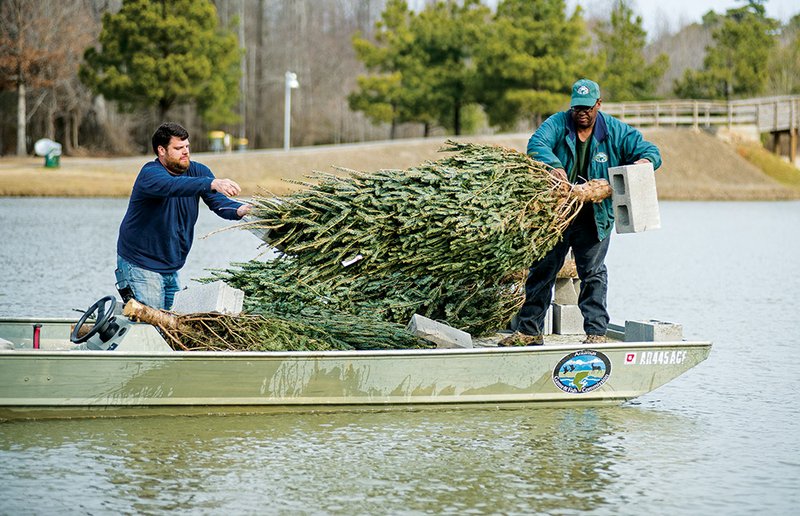BISMARCK — Fish in some Tri-Lakes Edition coverage area waters now have a new place to call home, thanks to the Arkansas Game and Fish Commission.
Officials with the AGFC sank Christmas trees in DeGray Lake for fish habitats earlier this year.
Ben Batten, program coordinator for the Arkansas Game and Fish Commission’s Family and Community Fishing Program, said this is something that happens every year.
“It’s a seasonal thing. We sink either used or unsold Christmas trees. It usually happens around January or February,” Batten said.
Batten said this is a way for the trees that would otherwise be thrown away to be put to good use.
“I think the reason we use Christmas trees is because they’re readily available,” he said.
The trees give the fish a place to hide from predators and build nests when preparing to lay eggs.
“These habitats provide [the fish] shelter, and [the habitats] also gather small insects and fish, which will bring in larger fish to feed. They give anglers a place where they know fish will be,” Batten said.
Fish in city-park ponds seem to thrive the most when a fish habitat is put into place, he said.
“A lot of times, [those ponds] are just like a bowl,” Batten said. “When they are stocked, the fish are usually young and totally vulnerable to predators.”
In larger lakes such as DeGray, Batten said, there are usually trees that naturally fall into the lake, creating fish habitats without the assistance of crews sinking trees into the water. Still, Mother Nature can sometimes use a helping hand in bigger water bodies that may lack cover, like DeGray or Greeson.
“We’re hoping that these habitats help improve fish populations,” Batten said.
Crappie, bass, bluegills and other fish will use these habitats, according to an AGFC news release.
Batten encourages others to recycle their trees next year if they have a chance.
“A lot of people even sink their own, and they have their own secret spots,” he said. “Please recycle your trees, and let us make them into fish habitats.”
Brett Hobbs, fisheries management biologist with the AGFC in Hot Springs, said fish habitat locations in DeGray Lake can be found on the commission’s website.
“If you go on the AGFC website, there’s a link to resources, then go to maps, and look for the interactive map. That’s going to tell people about all of the fish-cover work done,” Hobbs said.
The maps allow fishermen to download coordinates of the exact locations of the fish habitats. This year’s locations where tree work has been done include south of Caddo Drive, the west side of Big Hill Creek, Lenox Marcus Bay and Island 38, Hobbs said.
A list of tree drop-off locations is released around Christmastime each year.
For more information on area waters where the AGFC has placed fish structures, or for Family and Community Fishing Program locations, call the commission at (800) 364-4263 or visit www.agfc.com.
Staff writer Lisa Burnett can be reached at (501) 244-4307 or lburnett@arkansasonline.com.
